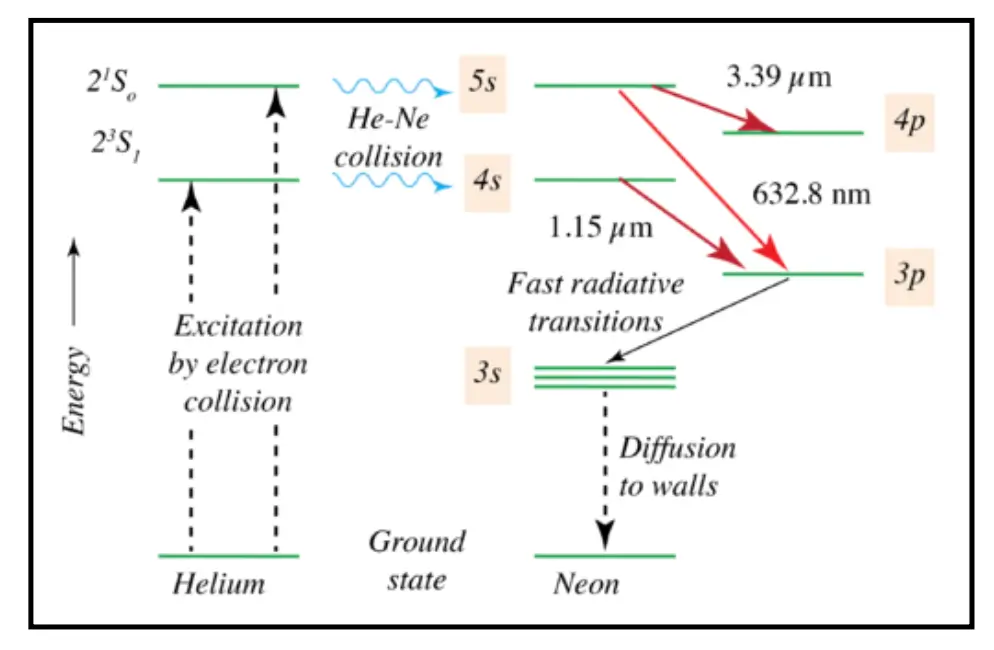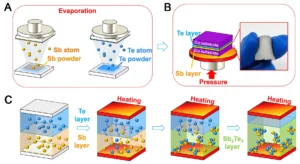The Helium-Neon (He-Ne) laser is a type of gas laser that has been widely used for various applications due to its coherent and monochromatic output. This article explores the construction, working principle, applications, and energy level diagram of the He-Ne laser in detail.
Introduction to He-Ne Laser
The Helium-Neon laser was first developed in 1960 by Ali Javan, William R. Bennett Jr., and Donald Herriott. It operates on the principle of stimulated emission of radiation, a concept introduced by Albert Einstein. The laser typically emits red light with a wavelength of 632.8 nm, although other wavelengths such as green, yellow, and infrared can also be produced.
Construction:
The He-Ne laser typically consists of the following components:
Gas Tube: The laser tube is a sealed glass container filled with a mixture of helium and neon gases. The tube is carefully constructed to maintain the purity of the gas mixture.

Mirrors: The ends of the laser tube have two mirrors – one highly reflective (HR mirror) and the other partially transparent (output coupler). These mirrors form an optical cavity, providing the feedback necessary for laser action.
Electrodes: Electrodes are used to apply a high voltage to the gas mixture, causing the excitation of the helium and neon atoms.
Working Principle:
The working principle of the He-Ne laser involves several steps:
Gas Excitation: High voltage applied to the electrodes excites the helium atoms, causing electrons to move to higher energy levels. These excited helium atoms then transfer their energy to neon atoms.
Population Inversion: The energy transfer results in a population inversion in the neon atoms, where more atoms are in higher energy states than in lower energy states.
Stimulated Emission: Photons collide with excited atoms, stimulating the emission of additional photons with the same energy, phase, and direction. This process leads to the generation of coherent light.
Optical Cavity: The mirrors at the ends of the tube create an optical cavity. Photons generated by stimulated emission bounce back and forth between the mirrors, amplifying and aligning into a coherent beam of light that exits through the partially transparent mirror.
Energy Level Diagram:

The energy level diagram of a He-Ne laser illustrates the energy levels of helium and neon atoms involved in the lasing process. It typically includes the ground state, excited states, and the energy levels corresponding to the laser transition. The specific energy levels are dependent on the characteristics of the helium and neon atoms in the laser tube. The transition from higher to lower energy states corresponds to the emission of laser light, contributing to the coherent output of the He-Ne laser.
Applications:
He-Ne lasers find applications in various fields:
1. Research and Education: Commonly used in laboratories and educational institutions for experiments and demonstrations due to their stable output.
2. Alignment Tasks: Preferred for precision alignment in industries and research environments owing to their visible and coherent light.
3. Holography: He-Ne lasers are crucial in holography due to their coherent and monochromatic characteristics.
4. Medical Instruments: Used in medical equipment, such as blood flow meters, for their ability to produce a stable and visible beam.
5. Bar Code Scanners: Older generations of bar code scanners utilized He-Ne lasers for their coherent output, which is suitable for barcode scanning applications.
6. Spectroscopy: Their narrow linewidth makes them suitable for Raman spectroscopy and other optical studies.
7. Communication: He-Ne lasers are employed in optical communication systems for transmitting signals.
Advantages of He-Ne Laser
1. High Stability:
He-Ne lasers offer excellent frequency and power stability.
2. Cost-Effective:
They are relatively inexpensive compared to other types of lasers.
3. Long Lifespan:
The gas mixture has a long operational life, reducing maintenance needs.
4. Low Power Consumption:
These lasers operate efficiently with minimal power requirements.
5. High Beam Quality:
He-Ne lasers produce a highly collimated and coherent beam.
Disadvantages of He-Ne Laser
1. Low Output Power:
The output power is limited, typically ranging from a few milliwatts to tens of milliwatts.
2. Bulky Design:
The long glass tube makes the laser less compact than semiconductor lasers.
3. Limited Wavelength Range:
While it primarily emits red light, other wavelengths are less commonly produced.
Future Prospects of He-Ne Lasers
Despite the advent of more advanced laser technologies like diode and solid-state lasers, He-Ne lasers remain relevant due to their unique characteristics. Future advancements may focus on improving their efficiency, compactness, and wavelength range to meet modern demands.
Conclusion
The Helium-Neon laser is a cornerstone in the history of laser technology. Its robust construction, straightforward working principle, and versatile applications make it an indispensable tool in science, education, and industry. Understanding the He-Ne laser’s construction, working mechanism, and energy-level diagram provides valuable insights into the broader field of laser physics and engineering.




